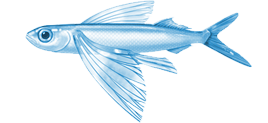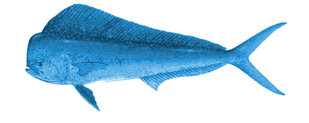LARGE PELAGICS FISHERIES CASE STUDY
Introduction
The pelagic zone of the seas and oceans includes the open waters of the oceans (oceanic waters) and the water column directly above continental shelves (coastal waters). The animal and plant species inhabiting pelagic waters are often referred to as pelagic species. The pelagic fish species are those inhabiting the pelagic waters. Important commercial fisheries for large oceanic, highly migratory pelagic fish (e.g. yellowfin tuna, skipjack tuna, swordfish, billfish); and more regional large pelagics (e.g. wahoo, dolphinfish, blackfin tuna and mackerel species) all occur within the Wider Caribbean region. The movement and migration of these stocks are transboundary; however the large regional pelagics are mostly confined to the Caribbean Large Marine Ecosystem (CLME) area, while the large oceanic pelagics go beyond this range.
Recreational fishing within the Caribbean targets a range of large pelagic species, and the region also attracts a multitude of international anglers wishing to target the large migratory tunas and billfishes
The International Commission for the Conservation of Atlantic Tuna (ICCAT) has management responsibility for some of the large pelagic species of the region. These include; all Atlantic tuna and billfish species, swordfish, several tuna-like species such as kingfish and mackerels, and 57 shark species. There are several large pelagic species that are either not included in the ICCAT mandate or not actively managed by ICCAT, but are important to the fisheries of Caribbean countries, such as dolphinfish, blackfin tuna, cero and king mackerels, wahoo and bullet tunas. The information base for effective governance and management of these species is virtually non-existent, perhaps because of the simultaneous absence of the relevant governance mechanism.
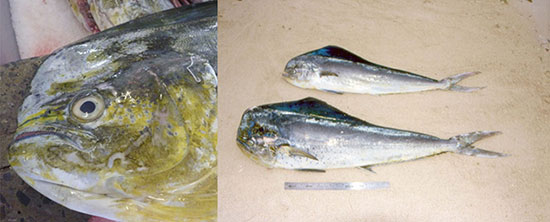
A one day symposium dedicated to scientific presentations and discussions of large pelagic fishes and fisheries convened as part of the Gulf and Caribbean Fisheries Institute annual conference November 5-10, 2006 in Belize City, Belize, concluded that “if overexploitation of the stocks of these transboundary species and the resulting negative impacts on fishers and user groups dependent upon them are to be avoided, sustainable utilization of large pelagics must be based on collaboration among countries in the context of regional management that is compatible with and functional within the existing management regimes”.
The CLME Project’s Overall Objective is the sustainable management of the shared living marine resources of the CLME and adjacent areas through an ecosystem-based management (EBM) approach that will meet the World Summit on Sustainable Development (WSSD) target for sustainable fisheries. Thus the CLME Case Study on the Large Pelagic Fishery of the Caribbean will complete a Transboundary Diagnostic Analysis (TDA) of the fishery which will fill important knowledge gaps and the TDA in turn, will inform the development of the Strategic Action Programme (SAP). The Case Study on the Large Pelagics will also contribute to the CLME management and governance framework which will outline priority actions for the sustainability of large pelagic fisheries. This will help to promote a cooperative mechanism for involvement of Caribbean countries in the activities of ICCAT for certain large pelagic species. It will also help to establish a regional mechanism for the management of other large pelagic species that are of significance to the Caribbean region but which are not currently being addressed by ICCAT.
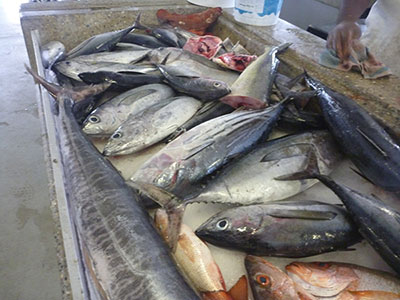
The Case Study will develop the information base for improving understanding of selected major large pelagic fisheries, including information on the nature and importance of recreational fishing activities, and to develop recommendations for promoting ecosystem-based management (EBM) in respect of large pelagic fisheries. EBM links the various sectors that share the use of marine ecosystems, e.g. fisheries, tourism, shipping, energy, and addresses complexity.
Goal
The large pelagic fishery case study aims to contribute to a Transboundary Diagnostic Analysis (TDA) for the fishery which would develop the information base for improving understanding of selected major large pelagic fisheries. The TDA, in turn, will inform the development of the Strategic Action Programme (SAP). The main focus of the large pelagic case study SAP activities will be to undertake a stakeholder analysis of the large pelagic fishery and an evaluation of the existing policy cycles and linkages among the countries involved in the large pelagic fisheries.
Objective
The CRFM large pelagic fishery case study seeks to promote the sustainable management of shared living marine resources of the wider Caribbean region by developing the information base for improving understanding of selected major large pelagic fisheries, including information on the nature and importance of recreational fisheries. The case study will also provide recommendations for promoting ecosystem approach to fisheries (EAF) management and governance in respect of large pelagic fisheries.
Geographic Scope
The general geographical area of the case study is the Wider Caribbean Region. Participating countries include: Barbados, Dominica, French West Indies (Martinique and Guadeloupe), Grenada, St. Lucia, St. Vincent and the Grenadines, Trinidad and Tobago, USA and Venezuela.
A Map of the Eastern Caribbean.
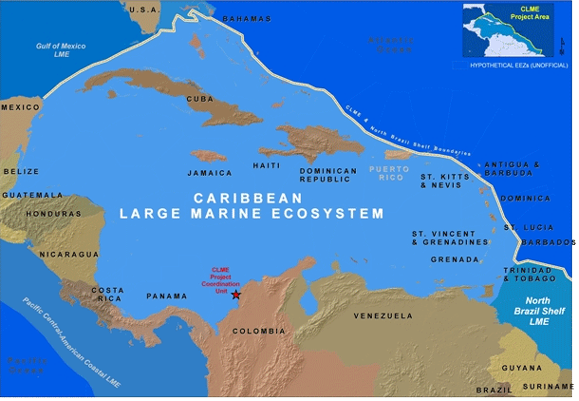
Project Components
TDA Gap Filling Activities:
-Enhancement of fisheries data collection for large pelagics with emphasis on selected major small tuna and tuna-like species and those species not under the jurisdiction of ICCAT (i.e dolphinfish, blackfin tuna).
-Undertake a region-wide assessment on the status of key regionally-distributed large pelagic species using available data and information.
-Assessment of the nature and importance of recreational fisheries in the region.
SAP Activities:
-Undertake (i) a stakeholder analysis and (ii) an evaluation of existing policy, legal and institutional arrangements and investments for management and governance of the large pelagic fishery of the region.
-Provide recommendations for reform of the large pelagic fishery of the region which will include the identification of a sub-regional decision-making forum and other policy, legal and institutional reforms and investments needed at local, national and subregional levels for effective governance and management of the fisheries and the ecosystem. Back to Top
Expected Outcomes
Recommendations for improving data collection systems for the evaluated large pelagic fisheries. Completed regional assessments of dolphinfish and blackfin tuna. An appraisal of the nature and importance of recreational fisheries.
A large pelagic stakeholder analysis, with information on primary & secondary stakeholders; and an assessment of their importance and influence regarding the governance of selected large pelagic fisheries.
An analysis of the policy, legal and institutional framework governing the large pelagic fishery of the region, including recommendations for reform of the large pelagic fishery of the region.

POSTAL ADDRESS: Edificio Chambacú - Oficina 405, Cra 13B# 26-78, Cartagena de Indias, Bolívar, Colombia
EMAIL: info@clmeproject.org


